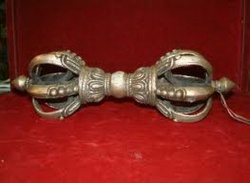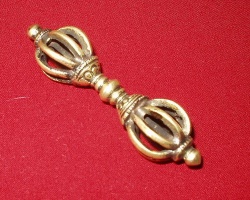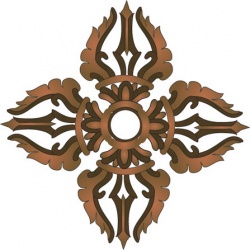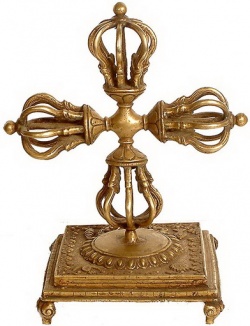The Dorje Vajra
By Sylvia Smelcer
The Vajra, or Dorje is a Buddhist symbol representing the nature of reality. Vajra is a reality wisdom, wisdom of equanimity, and all-accomplishing wisdom complementing at the other side. The significance of the symmetry of this symbol is to illustrate the unification of relative and absolute truth. The closing of the prongs at the end of the symbol represent closing the wheels of Samsara, or the realization of Enlightenment.
The vajra is the yang counterpart used in Tantric Buddhist rites in conjunction with the yin ghanta (or bell). When deities are depicted holding a vajra and ghanta in each hand, this symbolizes the masculine and feminine union of wisdom and compassion. There is also a vajraghanta, which is a bell whose stem bears one of the two lotuses of the vajra.
The prefix vajra is used often in Buddhism, particularly Tantric Buddhism. The vajra prefix adds a transcendental connotation to names of deities and more subtle words. For example, a vajrasattva, or "diamond heart" is a transcendental deity who has assumed a vajrakaya, or transcendental body. Yogis may know the posture vajrasana, a seated position akin to basic seated kneeling, which is said to ascribe transcendental qualities to the practitioner.
A vajra is transformed from symbol to spiritual instrument in the form of a prop used in Buddhist, Jainist and Hindu rituals. The tool vaguely resembles a barbell with a crown on each end. Beyond its native origins in India and Tibet, the vajra can be used not only as a religious symbol, but also as a weapon in other countries as close as Nepal all the way to Korea and Japan. The weapon is likened to its namesake in that it can cut through all like a diamond, and also has the power of the mighty thunderbolt.
Not surprisingly, the vajra can be found in the depictions of many Buddhist icons. When seen in the hands on a doubtlessly capable deity, it signifies that the Buddha is able to apply remarkable skill and technique to his or her application of the Dharma. One who meditates on the vajra may achieve the "thunderbolt experience", wherein the practitioner experiences a merging between the relative and absolute truths. The vajra is often seen in a doubled form called the vajra cross, or visvavajra. This, of course, perpendicularly connects two vajras to form a "plus" sign or "x". The Sanskrit term vishva means "the universe as we experience it". The visvavajra symbol is often used in a seal at the base of statues to protect and enclose the prayers that reside inside it.
The significance of the diamond in Buddhist tradition is that it has the clarity and strength of the substance, and possesses a high amount of spiritual powers. The diamond represents immortality and invulnerability. The diamond is associated with one of the five kleshas, or the mastery of transforming anger into mirror-like wisdom. The powerful and masculine force of the vajra inspires many Buddhist devotees to summon an indestructible and prevailing power on their road of Enlightenment. This intricate and remarkable symbol and its physical embodiment as a ritualistic prop and weapon provide vital strength for all following the path of the dharma. Sanskrit word meaning either thunderbolt or diamond.
Dorje is Tibet's word for vajra, which is also a common name for boys in that country. The formation of the vajra symbol begins with a sphere that represents Sunyata, or the void (emptiness, or enduring entity of existence). On each side of the sphere stacks three rings, which represent emptiness, signlessness and effortlessness, or the three blisses of Buddhahood. From each of the two groups of rings bloom two lotuses with eight petals. The lotus, of course, can represent many things, but here it is mostly representative of enlightenment. The sixteen petals petals stand for the sixteen modes of emptiness. These petals can also represent the eight bodhisattvas and their female counterparts.
Beyond the lotus petals one will find another two sets of three rings, together signifying the six perfections: patience, generosity, discipline, effort, meditation and wisdom. Out of these rings emerge five prongs, of which four of these prongs curve toward one central prong, forming a closed claw or cage of sorts. The four outer prongs represent the four aggregates of: form, feeling, perception and motivation, with the central prong connoting consciousness. The five prongs can also denote the five poisons and wisdoms of: desire, anger, delusion, greed and pride - with the: wisdom of individuality, mirror-like wisdom,
The diamond represents immortality and invulnerability. The diamond is associated with one of the five kleshas, or the mastery of transforming anger into mirror-like wisdom. The powerful and masculine force of the vajra inspires many Buddhist devotees to summon an indestructible and prevailing power on their road of Enlightenment. This intricate and remarkable symbol and its physical embodiment as a ritualistic prop and weapon provide vital strength for all following the path of the dharma.



